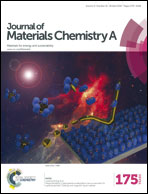Hierarchically porous Fe3O4/C nanocomposite microspheres via a CO2 bubble-templated hydrothermal approach as high-rate and high-capacity anode materials for lithium-ion batteries
Abstract
Hierarchically porous Fe3O4/C nanocomposite microspheres, composed of open pores with an average size of 68 nm in diameter and nanostructured carbon walls, which are ∼21 nm in thickness and embedded homogenously with ∼8.1 nm Fe3O4 nanocrystals and ∼8.8 nm nanopores, were successfully prepared for the first time by a hydrothermal process using iron chloride hexahydrate, tri-sodium citrate, polyvinylpyrrolidone, glucose and sodium carbonate as starting materials. On the basis of their microstructural characterization by XRD, FESEM, HRTEM, BET, XPS and Raman techniques, it has been found that the self-aggregation of CO2 mini-bubbles confined by PVP and ultrafine Fe(OH)3 particles decorated with citrate groups via the molecular chain entanglements during the condensation and carbonization of glucose should be responsible for the formation of the microspherical precursory agglomerates, which are then turned into the porous Fe3O4/C microspheres with complex microstructures. Moreover, when tested as anode materials in LIBs, these porous Fe3O4/C microspheres show superior electrochemical performances, including a high reversible capacity of 1231.3 mA h g−1 at 0.5 A g−1 after 100 cycles, and 1017.2 mA h g−1 at 1 A g−1 and 601.9 mA h g−1 at 5 A g−1 over 500 cycles. With a particle-size control model proposed herein, the cycle discharging behaviors of the porous Fe3O4/C microspheres as anode materials are well explained to mainly depend on the size dispersion and local effective confinement of Fe3O4 nanoparticles inside the porous carbon matrix during their dynamic refinements in the redox cycles.

- This article is part of the themed collection: 2016 Journal of Materials Chemistry A HOT Papers

 Please wait while we load your content...
Please wait while we load your content...